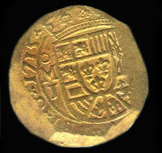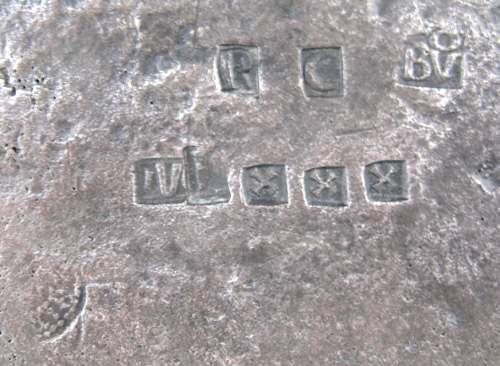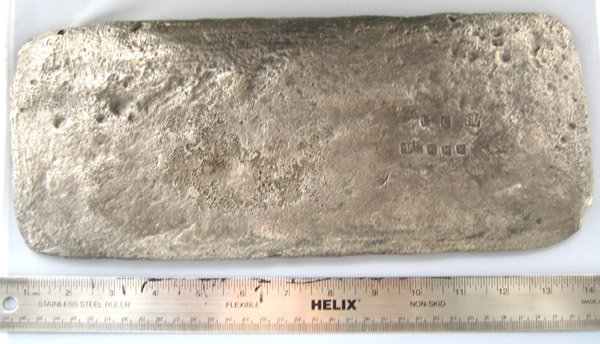 |
|
|
|
|
||
|
Charles I |
From the Los Mimbres Shipwreck
Los Mimbres Ingot M101 (sold)
weight : 12.62 lbs (4710 gms) dimensions: 35.5 x 15 x 1.5 cm sigla: Bvo ( Bernardino Vazquez de Tapia) control: R C Ley/ fineness: iVLxxx = 1080 style of ley: common caroline second assay: no quinto/ tax stamp: one (visible to the lower left above) place and date of production: Tarascan Michoacan, Mexico, 1523-24
M101 is a larger Tarascan Bvo ingot, at 12.6 lbs just about twice the size of the average ingot recovered from the Los Mimbres Treasure. More than half of the Los Mimbres bars and discs carry Bernardino Vazquez's Bvo mark. No-one has yet done an exact calculation on over 100 Bvo bars and discs, but we can easily estimate that we have more than 500 lbs of unrefined silver (plus gold) are sitting in just these Bvo bars and discs. (M101 itself has 68 ozs of pure silver and about 3 ozs of pure gold if the Bvo’s assay is correct.) Understand that that was real fortune by the standards of 1525, but it was not negotiable or spendable wealth so long as the gold and silver was sitting in unrefined ingots. Especially after the royal inspection of 1525 cast serious doubt on the reliability of the Tarascan assays, Tarascan ingots could not expect to be accepted into commerce. They would not circulate as “necessity money”. They were not part of the monetary/economic system of New Spain because of their uncertain value. Someone who wanted to spend his share of the Tarascan treasure, someone who needed to pay taxes or deal with the Colonial government, someone who wanted to monetize his ingots for any number of reasons, needed to have his unrefined bars converted into properly refined ingots, or ideally, into coinage.
As a rule unrefined ingots throughout the Americas did not survive longer than the time it took to transport them to the nearest foundry. The very few examples that survive were lost in transit. The only reason that the Los Mimbres ingots escaped a quick trip to the melting pot was that in years prior to 1525-26 Cortes’ foundries did not have the capacity to refine all the treasure he was collecting from Michoacan and elsewhere. Capacity was increased significantly in 1526 to accommodate the mandated recall of unrefined ingots (a recall that owners of Tarascan bars did not in fact oppose). By 1528-29 the last Tarascan ingots were in the melting pot—except of course for those that had already left Mexico!
Tarascan Bvo bars were not being smuggled out Mexico. Bernardino Vazquez's assays had retested well and the bars showed a quinto. They were legal to export UNTIL the recall ended. Several of Cortes’ associates returned to Spain in the period 1526-28, including Cortes himself in 1528. It is easy to suppose that the Los Mimbres ingots represented the wealth accumulated by a prominent Conquistador, who was himself returning to Spain or shipping his treasure back to Spain at this time. As we discussed on the previous page, there is a good chance that on-going archival work in Spain will discover the identity of this Cortes galleon and perhaps through its manifest tell us whose treasure came to grief on the Los Mimbres shoals. References: Armstrong p. 51, Garcia-Barneche p. 130
The last time a large Mimbres ingot came to auction, M70 (10.4 lbs) brought $10,350 in Treasure Auction 11. M101 is a larger and more clearly marked ingot.
SOLD
terravitan@aol.com or 480-595-1293
|
|



